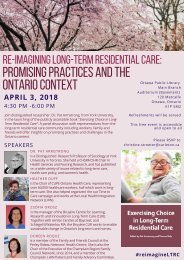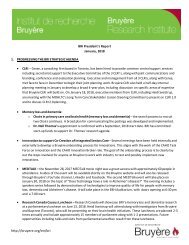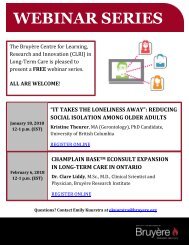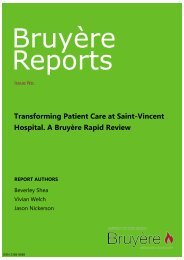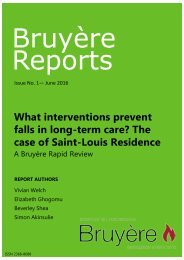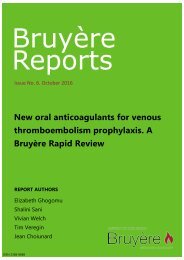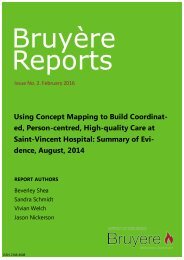Falls Prevention in Continuing Care
You also want an ePaper? Increase the reach of your titles
YUMPU automatically turns print PDFs into web optimized ePapers that Google loves.
Discussion of evidence review:<br />
strengths and limitations<br />
One limitation of these recommendations is that there<br />
is uncerta<strong>in</strong>ty about the components of multifactorial<br />
<strong>in</strong>terventions as they are not assessed <strong>in</strong>dividually. For<br />
example, multifactorial risk assessment could <strong>in</strong>clude<br />
identification of falls history; assessment of gait, balance<br />
and mobility, and muscle weakness; assessment<br />
of osteoporosis risk; assessment of the older person’s<br />
perceived functional ability and fear relat<strong>in</strong>g to fall<strong>in</strong>g;<br />
assessment of visual impairment; assessment of cognitive<br />
impairment and neurological exam<strong>in</strong>ation; assessment<br />
of ur<strong>in</strong>ary <strong>in</strong>cont<strong>in</strong>ence; assessment of environmental<br />
hazards; cardiovascular exam<strong>in</strong>ation, medication<br />
review, exercise, client education, hip protector,<br />
physical restra<strong>in</strong>t, <strong>in</strong> different comb<strong>in</strong>ations. However,<br />
evidence regard<strong>in</strong>g the use of multifactorial rather<br />
than unifactorial <strong>in</strong>terventions is supported by two<br />
moderate quality systematic reviews which compared<br />
the effects across this dimension(13, 15).]<br />
There are a small number of studies, and studies are<br />
not available <strong>in</strong> all sett<strong>in</strong>gs, thus requir<strong>in</strong>g judgments<br />
about whether results from one sett<strong>in</strong>g can be transferred<br />
to a different sett<strong>in</strong>g.<br />
Regard<strong>in</strong>g vitam<strong>in</strong> D, although there is evidence of<br />
benefit from randomized trials, there is controversy as<br />
to what dose of vitam<strong>in</strong> D should be given to prevent<br />
falls <strong>in</strong> older peopleThe RNAO guidel<strong>in</strong>es recommend<br />
vitam<strong>in</strong> D supplementation for residents s<strong>in</strong>ce people<br />
<strong>in</strong> Canada have a risk for vitam<strong>in</strong> D <strong>in</strong>sufficiency or deficiency<br />
because the production of vitam<strong>in</strong> D <strong>in</strong> the<br />
sk<strong>in</strong> falls to near zero for four to five months of the<br />
year <strong>in</strong> Canada.<br />
Implementation of falls prevention <strong>in</strong>terventions<br />
Comprehensive falls risk assessment is an <strong>in</strong>tegral part<br />
of an effective multifactorial fall prevention program as<br />
targeted <strong>in</strong>terventions to address a patient’s identified<br />
risk factors are implemented. All three guidel<strong>in</strong>es describe<br />
a comprehensive risk assessment to <strong>in</strong>clude:<br />
<br />
<br />
<br />
<br />
<br />
<br />
<br />
identification of falls history,<br />
cognitive impairment,<br />
cont<strong>in</strong>ence problems,<br />
footwear that is unsuitable or miss<strong>in</strong>g<br />
health problems that may <strong>in</strong>crease their risk of<br />
fall<strong>in</strong>g (such as osteoporosis)<br />
medication review<br />
postural <strong>in</strong>stability, mobility problems and/or balance<br />
problems<br />
syncope syndrome<br />
<br />
visual impairment<br />
neurological exam<strong>in</strong>ation<br />
environmental hazards<br />
This assessment should be done by a multidiscipl<strong>in</strong>ary<br />
team if possible or by a healthcare professional with<br />
appropriate skills and experience.<br />
A post-fall risk assessment helps identify the reasons<br />
for the fall and guide actions taken to prevent future<br />
falls. A comprehensive post-fall assessment <strong>in</strong>volves<br />
<strong>in</strong>terdiscipl<strong>in</strong>ary communication, consultation and<br />
analysis of the circumstances surround<strong>in</strong>g the fall,<br />
physical exam<strong>in</strong>ation of the patient, medication review,<br />
assessment of exist<strong>in</strong>g <strong>in</strong>terventions to prevent falls<br />
and their implementation, and a falls risk assessment<br />
to identify new modifiable risk factors. The post-fall<br />
risk assessment should be iterative as <strong>in</strong>jury may not<br />
be apparent until even weeks after the fall. It should be<br />
followed up with a new <strong>in</strong>dividualized care plan to reduce<br />
falls. The post-fall staff huddles process has been<br />
used with success <strong>in</strong> the long term care sett<strong>in</strong>g to<br />
identify required changes to the care plan(21).<br />
The staff should be encouraged to share risk <strong>in</strong>formation<br />
with clients/patients/residents and their family,<br />
discuss risk reduction strategies that the <strong>in</strong>dividual can<br />
take to prevent falls, and implement <strong>in</strong>terventions that<br />
are compatible with the patient’s risk factors and preferences.<br />
9



